Flanagan Surname Ancestry ResultsOur indexes 1000-1999 include entries for the spelling 'flanagan'. In the period you have requested, we have the following 315 records (displaying 231 to 240): Single Surname Subscription | | | Buying all 315 results of this search individually would cost £1,862.00. But you can have free access to all 315 records for a year, to view, to save and print, for £100. Save £1,762.00. More... |
These sample scans are from the original record. You will get scans of the full pages or articles where the surname you searched for has been found. Your web browser may prevent the sample windows from opening; in this case please change your browser settings to allow pop-up windows from this site.  Outstanding soldiers of the Highland Light Infantry
(1881-1901) Outstanding soldiers of the Highland Light Infantry
(1881-1901)
Each year the best soldiers of the regiment were chosen for long service and good conduct medals. This register gives rank, name, regimental number, and date of recommendation. (The sample scan is from the East Surrey regiment). The register is essentially a register of recommendations, annotated with details of the issue of the medals. Where no gratuity accompanied the medal, the entry is marked 'W. G.' (without gratuity); where, for one reason or another, the medal was not issued, the entry is marked 'N. S.' (not sanctioned) and struck through. The regiment was based on the 71st Regimental District - Hamilton. The 1st battalion returned from Gibraltar in 1880, and in 1885 was stationed at Dublin. It embarked for Malta 9 February 1895, and thence to South Africa ("South Africa, 1899-1902" and "Modder River"). The 2nd battalion left for Egypt in 1882, and there added "Egypt, 1882" and "Tel-el-Kebir" to the regimental honours. Having briefly returned to England, the battalion embarked for India 1 October 1884, and in 1885 was at Dugshai in Bengal, in 1895 at Fyzabad. It took part in the North West Frontier campaign of 1897 to 1898, and in 1899 moved on to Ceylon, returning to England in 1900.FLANAGAN. Cost: £8.00.  | Sample scan, click to enlarge
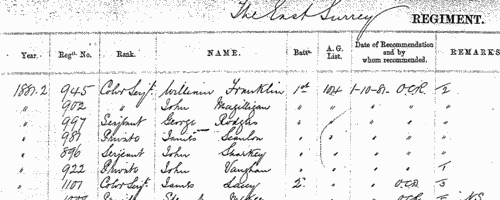
|  Outstanding soldiers of the Leicestershire Regiment
(1881-1901) Outstanding soldiers of the Leicestershire Regiment
(1881-1901)
Each year the best soldiers of the regiment were chosen for long service and good conduct medals. This register gives rank, name, regimental number, and date of recommendation. (The sample scan is from the East Surrey regiment). The register is essentially a register of recommendations, annotated with details of the issue of the medals. Where no gratuity accompanied the medal, the entry is marked 'W. G.' (without gratuity); where, for one reason or another, the medal was not issued, the entry is marked 'N. S.' (not sanctioned) and struck through. The regiment was based on the 17th Regimental District - Leicester. The 1st battalion returned from Bengal in 1882, and in 1885 was at Aldershot. It embarked for Bermuda 16 September 1888, was sent on to Halifax, Nova Scotia, and in 1893 to the West Indies. In 1895 the battalion was moved to South Africa, taking part in the Boer war of 1899 to 1902, fighting at Talana, Lombard's Kop, the defence of Ladysmith, Amesfoort, Ermelo, Geluk Farm, Bergendal and Badfontein; mentioned in despatches at Lyndenburg, operations in the Eastern Transvaal, Swaziland border, South Eastern Transvaal, and Slangapies ("South Africa, 1900-1902", "Defence of Ladysmith"). The 2nd battalion embarked for India 5 October 1876, and in 1885 was at Jubbulpore; it returned from India via Burmah (1888-1889) and Aden 1 December 1890, and in 1895 was at Aldershot. The battalion was moved to Ireland in 1896, and from there to Egypt in 1900.FLANAGAN. Cost: £8.00.  | Sample scan, click to enlarge
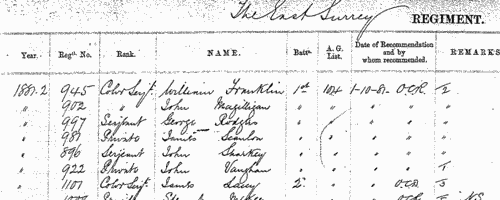
|  Outstanding soldiers of the Royal Fusiliers (City of London Regiment)
(1881-1901) Outstanding soldiers of the Royal Fusiliers (City of London Regiment)
(1881-1901)
Each year the best soldiers of the regiment were chosen for long service and good conduct medals. This register gives rank, name, regimental number, and date of recommendation. (The sample scan is from the East Surrey regiment). The register is essentially a register of recommendations, annotated with details of the issue of the medals. Where no gratuity accompanied the medal, the entry is marked 'W. G.' (without gratuity); where, for one reason or another, the medal was not issued, the entry is marked 'N. S.' (not sanctioned) and struck through. The regiment was based on the 7th Regimental District - Hounslow. The 1st battalion embarked for Gibraltar in 1885, and went on to India: it was based at Kurrachee by 1895. The 2nd battalion embarked for India 1 October 1873, and in 1885 was at Cannanore in Madras; it returned from India to England 29 March 1889, was moved to Ireland from Guernsey in 1895, and sent on to South Africa in 1899, where it added "South Africa, 1899-1902" and "Relief of Ladysmith" to the regimental honours.FLANAGAN. Cost: £8.00.  | Sample scan, click to enlarge
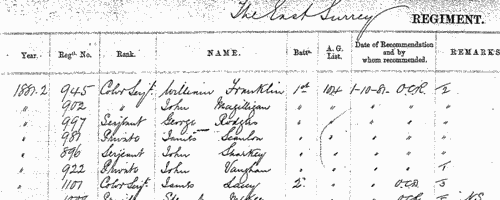
|  Outstanding soldiers of the Royal West Surrey Regiment
(1881-1901) Outstanding soldiers of the Royal West Surrey Regiment
(1881-1901)
Each year the best soldiers of the regiment were chosen for long service and good conduct medals. This register gives rank, name, regimental number, and date of recommendation. (The sample scan is from the East Surrey regiment). The register is essentially a register of recommendations, annotated with details of the issue of the medals. Where no gratuity accompanied the medal, the entry is marked 'W. G.' (without gratuity); where, for one reason or another, the medal was not issued, the entry is marked 'N. S.' (not sanctioned) and struck through. The regiment was based on the 2nd Regimental District - Guildford. The 1st battalion returned from Bombay in 1879, and by 1885 was established at Tralee. It embarked for Malta 24 December 1891, and moved on to India, where it was stationed at Umballa in Bengal by 1895. The 2nd battalion embarked for Malta 26 July 1877, going on to India in 1878, and in 1885 was at Cawnpore. The battalion was moved into Upper Burmah in 1886 ("Burma, 1885-1887" and "Tirah"), back to India in 1888, returning to England in 1894. In 1899 the 2nd battalion was sent to South Africa, adding "South Africa, 1899-1902" and "Relief of Ladysmith" to the colours.FLANAGAN. Cost: £8.00.  | Sample scan, click to enlarge
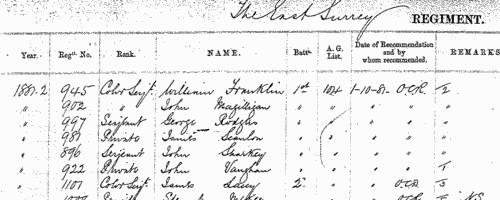
|  Outstanding soldiers of the Sherwood Foresters (Derbyshire Regiment)
(1881-1901) Outstanding soldiers of the Sherwood Foresters (Derbyshire Regiment)
(1881-1901)
Each year the best soldiers of the regiment were chosen for long service and good conduct medals. This register gives rank, name, regimental number, and date of recommendation. (The sample scan is from the East Surrey regiment). The register is essentially a register of recommendations, annotated with details of the issue of the medals. Where no gratuity accompanied the medal, the entry is marked 'W. G.' (without gratuity); where, for one reason or another, the medal was not issued, the entry is marked 'N. S.' (not sanctioned) and struck through. The regiment was based on Regimental District No. 45 - Derby. The 1st battalion returned from India in March 1878, and in 1885 was at Athlone; in 1895 at Dublin. The 2nd battalion embarked for Gibraltar in 1881, was sent on to Egypt in 1882 (gaining the honour "Egypt, 1882"), and in the same year on to India, being stationed at Lucknow by 1885. The battalion took part in the Sikkim Expedition of 1888 and the North-West Frontier Campaign of 1897-1898, returning to Aden in 1898. The regiment gained the honour "South Africa, 1899-1902".FLANAGAN. Cost: £8.00.  | Sample scan, click to enlarge
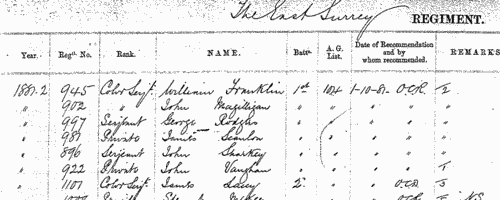
|  British artillerymen fighting in South Africa
(1899-1902) British artillerymen fighting in South Africa
(1899-1902)
The Queen Victoria's South Africa Medal was awarded (after her death, in the event) to all who had served honourably in the various campaigns in the Boer War. Returns were made from each unit, and consolidated into nominal roll, of which this is the one for the Royal Artillery. Confusingly, the ledgers used had originally been printed for a register of men transferred (or re-transferred after mobilization) to 1st Class Army Reserve. All the original column headings were therefore struck through, and the roll was prepared with this information: Date of Issue; Regimental Number; Rank; Name; Unit; Medal (a 1 indicating that a medal was awarded); [number of] Clasps; the reference to the source in the original returns, usually starting with AG for papers in the hands of the Adjutant-General, and 68/Art/ for the Royal Artillery records. The final column, normally left blank, was occasionally used for explanatory remarks.FLANAGAN. Cost: £8.00.  | Sample scan, click to enlarge

| Surgents and Agents at Naval Sick Quarters
(1904)
The Monthly Naval List for November 1904, printed By Authority for the Admiralty, contains this list of surgeons and agents at naval Sick Quarters.FLANAGAN. Cost: £4.00.  | Sample scan, click to enlarge
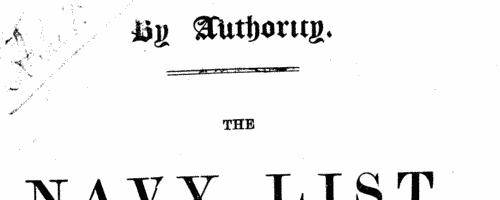
|  Queen's South Africa Medal: Royal Field Artillery: 63rd Battery
(1901-1905) Queen's South Africa Medal: Royal Field Artillery: 63rd Battery
(1901-1905)
The nominal roll for the Queen Victoria's South Africa Medal - awarded (after her death, in the event) to all who had served honourably in the various campaigns in the Boer War - was compiled from these returns from the individual units. Two sets of form were completed. The main one, as in the sample scan, dates from 1901 and gives regimental number, rank, and full name (surname first), followed by a series of columns relating to different actions - Belmont, Modder River, Paardeberg, Dreifontein, Wepener, Johannesburg, Diamond Hill, Belfast, Wittebergen, Defence of Kimberley, Relief of Kimberley, Defence of Mafeking, Relief of Mafeking, Cape Colony, Orange Free State, Transvaal, Rhodesia, Talana, Elandslaagte, Tugela Heights, Defence of Ladysmith, Relief of Ladysmith, Laing's Nek, and Natal; each entitled the man to a separate clasp to the medal, and a tick or a Yes in the appropriate column indicates the man's actual physical presence in that battle. A final column for remarks is important in those cases where the man was no longer in the unit, by removal, death or desertion. The second form that sometimes occurs was returned in 1905, and covers men entitled to the Second South African War Medal and Clasps. It lists men by number, rank and name, checks whether they had claimed the Queen's South Africa Medal, and then enquires as to their suitability as to three Colony Clasps, which could be awarded for service in the Cape, Orange Free, or Transvaal; whether entitled to Date Clasps (South Africa 1901 and South Africa 1902); whether also entitled to the King's South Africa Medal; any other corps in which served in South Africa; and remarks (such as becoming non-effective, forfeiture, &c.) WO 100/142
FLANAGAN. Cost: £8.00.  | Sample scan, click to enlarge

|  Queen's South Africa Medal: Royal Field Artillery: 69th Battery
(1901-1905) Queen's South Africa Medal: Royal Field Artillery: 69th Battery
(1901-1905)
The nominal roll for the Queen Victoria's South Africa Medal - awarded (after her death, in the event) to all who had served honourably in the various campaigns in the Boer War - was compiled from these returns from the individual units. Two sets of form were completed. The main one, as in the sample scan, dates from 1901 and gives regimental number, rank, and full name (surname first), followed by a series of columns relating to different actions - Belmont, Modder River, Paardeberg, Dreifontein, Wepener, Johannesburg, Diamond Hill, Belfast, Wittebergen, Defence of Kimberley, Relief of Kimberley, Defence of Mafeking, Relief of Mafeking, Cape Colony, Orange Free State, Transvaal, Rhodesia, Talana, Elandslaagte, Tugela Heights, Defence of Ladysmith, Relief of Ladysmith, Laing's Nek, and Natal; each entitled the man to a separate clasp to the medal, and a tick or a Yes in the appropriate column indicates the man's actual physical presence in that battle. A final column for remarks is important in those cases where the man was no longer in the unit, by removal, death or desertion. The second form that sometimes occurs was returned in 1905, and covers men entitled to the Second South African War Medal and Clasps. It lists men by number, rank and name, checks whether they had claimed the Queen's South Africa Medal, and then enquires as to their suitability as to three Colony Clasps, which could be awarded for service in the Cape, Orange Free, or Transvaal; whether entitled to Date Clasps (South Africa 1901 and South Africa 1902); whether also entitled to the King's South Africa Medal; any other corps in which served in South Africa; and remarks (such as becoming non-effective, forfeiture, &c.) WO 100/142
FLANAGAN. Cost: £8.00.  | Sample scan, click to enlarge

|  Queen's South Africa Medal: Royal Field Artillery: 78th Battery
(1901-1905) Queen's South Africa Medal: Royal Field Artillery: 78th Battery
(1901-1905)
The nominal roll for the Queen Victoria's South Africa Medal - awarded (after her death, in the event) to all who had served honourably in the various campaigns in the Boer War - was compiled from these returns from the individual units. Two sets of form were completed. The main one, as in the sample scan, dates from 1901 and gives regimental number, rank, and full name (surname first), followed by a series of columns relating to different actions - Belmont, Modder River, Paardeberg, Dreifontein, Wepener, Johannesburg, Diamond Hill, Belfast, Wittebergen, Defence of Kimberley, Relief of Kimberley, Defence of Mafeking, Relief of Mafeking, Cape Colony, Orange Free State, Transvaal, Rhodesia, Talana, Elandslaagte, Tugela Heights, Defence of Ladysmith, Relief of Ladysmith, Laing's Nek, and Natal; each entitled the man to a separate clasp to the medal, and a tick or a Yes in the appropriate column indicates the man's actual physical presence in that battle. A final column for remarks is important in those cases where the man was no longer in the unit, by removal, death or desertion. The second form that sometimes occurs was returned in 1905, and covers men entitled to the Second South African War Medal and Clasps. It lists men by number, rank and name, checks whether they had claimed the Queen's South Africa Medal, and then enquires as to their suitability as to three Colony Clasps, which could be awarded for service in the Cape, Orange Free, or Transvaal; whether entitled to Date Clasps (South Africa 1901 and South Africa 1902); whether also entitled to the King's South Africa Medal; any other corps in which served in South Africa; and remarks (such as becoming non-effective, forfeiture, &c.) WO 100/143FLANAGAN. Cost: £8.00.  | Sample scan, click to enlarge

|
Research your ancestry, family history, genealogy and one-name study by direct access to original records and archives indexed by surname.
|













